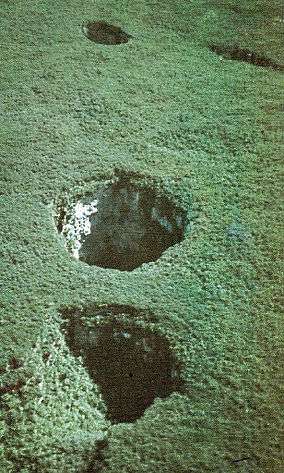Sima Humboldt
| Sima Humboldt | |
|---|---|
|
Sima Humboldt is seen in middle of picture, in the far background is Sima Martel | |
| Location | Venezuela, Bolívar (state), Sarisariñama |
| Coordinates | 4°41′08″N 64°13′07″W / 4.6855°N 64.2185°WCoordinates: 4°41′08″N 64°13′07″W / 4.6855°N 64.2185°W |
| Depth | 314 m (1,030 ft) |
| Discovery | 1961 |
| Geology | Quartzite |
| Access | By special researcher permit only |
Sima Humboldt (Sima Mayor) is an enormous sinkhole located on the summit of the plateau of Sarisariñama tepui in Bolívar State, Venezuela. It is unusual for several reasons, including its enormous size and depth, its location on the top of the only forested tepui, having a patch of forest on its base and also due to the weathering process that formed this sinkhole. The feature is named after scientist and explorer Alexander von Humboldt.
Together with the neighbouring Sima Martel, it was first spotted in 1961 by pilot Harry Gibson.[1]
The sinkhole was descended for the first time in 1974 and more thoroughly explored in 1976. Its volume is 18,000,000 m3 (640,000,000 cu ft), whereas the maximum width at its upper rim is 352 m (1,155 ft) and 502 m (1,647 ft) below.[2]
Only 700 metres from the rim of Sima Humboldt there is another enormous sinkhole, Sima Martel. In total there are four caves on Sarisariñama.
References
- ↑ Huber, Otto & Wurdack, John J. (1984). "History of Botanical Exploration in Territorio Federal Amazonas, Venezuela" (PDF). Smithsonian Institution Press, City of Washington.
- ↑ (In Spanish) Miguel Lentino, Diana Esclasans. "Important Areas for the Conservation of Birds in Venezuela". In: Birdlife and Conservation International. Important Areas for the Conservation of Birds in the Tropical Andes: Priority Sites for the Maintenance of Biodiversity. ("Áreas Importantes Para La Conservación De Las Aves En Venezuela". In: BirdLife International y Conservation International. Áreas Importantes para la Conservación de las Aves en los Andes Tropicales: sitios prioritarios para la conservación de la biodiversidad.) Quito, Ecuador: BirdLife International (Serie de Conservación de BirdLife No. 14), S. 621-730, 2005.
